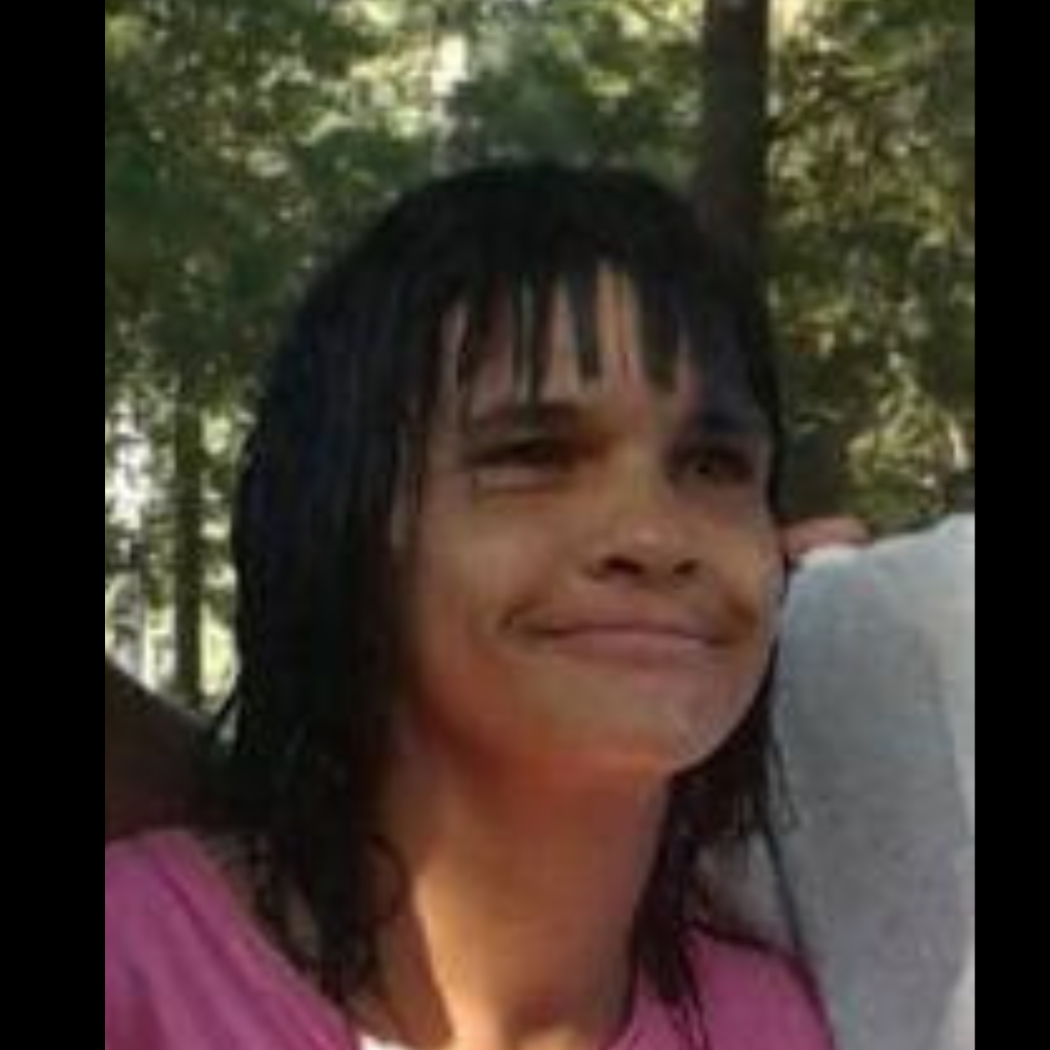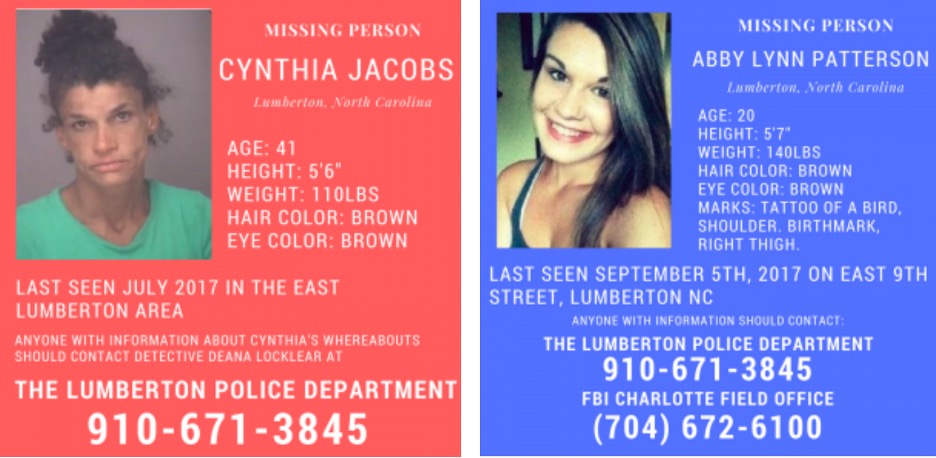Over the course of a few months in the summer of 2017, two women from Lumberton, NC, went missing, Cynthia Jacobs and Abby Lynn Patterson.
Cynthia was last seen in East Lumberton in July of 2017. She was 41 years old at the time of her disappearance.
Abby was last seen getting into a car with a male acquaintance on East 9th Street in Lumberton, NC. She was 20 years old at the time of her disappearance.
Many people in Lumberton believe that the disappearances of Cynthia and Abby are related to murders of three women from around the same time – Rhonda Jones (Lumbee), Christina “Kristin” Bennett, and Megan Oxendine (Lumbee).
These women were all found deceased in the same neighborhood within three weeks in April and May of 2017. Rhonda’s body was found naked and stuffed into a trash can, Kristin’s body was found in a nearby abandoned house, and Megan’s body was found just three blocks away.
Cynthia Jacob’s sister-in-law reported that Cynthia was the last person to see Megan Oxendine (the third woman found) alive.[1]
While people in the area believe that Cynthia’s and Abby’s disappearance are likely related, Captain Terry Parker of the Lumberton Police Department told CBS 17 that “while there is always a possibility, we are 99 percent sure the case is not related to the females this spring and early summer.”
People living in Lumberton are not strangers to violence – Robeson County, where Lumberton is located, consistently ranks highest among North Carolina’s counties for violent crime. The violence, however, does not affect all citizens equally. Robeson County is home to large Indigenous populations (43% of the county identified as Native American only), and is particularly dangerous for Indigenous women and girls.
According to the Violence Against Women Act (VAWA) of 2022, Indigenous women face a murder rate that is up to 10 times the national average in some areas. Indigenous woman are 2.5 times as likely to experience violent crimes, and over 2 times as likely to experience rape or sexual assault. Of the Indigenous women who have experienced violence, 96% of them have experienced sexual violence by a non-Indigenous perpetrator.
But not only are Indigenous women more likely to face violence, they also are more likely to face obstacles when seeking justice.
The responses to the disappearances of Cynthia, an Indigenous woman, and Abby, a white woman, exemplify this discrepancy.
Although both cases are still open and assigned to a corresponding officer, the attention and progress in each case have varied greatly. Cynthia’s case received little attention and it is challenging to find online resources or information relating to the case. In contrast, Abby’s case is ongoing and active – she currently has a profile on FBI’s Most Wanted Missing Persons.
In addition to race, there are many reasons why law enforcement, or the general public, might take the murder or disappearance of one woman more seriously than another. Educational attainment, employment, socioeconomic status, and previous criminal activity are all important factors in shaping the public’s response to a disappearance or murder. Through weighing these different factors, we decide the worth or value of that person and, thus, the resources and attention that should be devoted to their case.
Even though the disappearance of any woman should be treated with urgency and care, the reaction of law enforcement to the disappearances of women suspected of using substances or engaging in sex work often is markedly less pronounced. For example, the disappearances of a white woman and an Indigenous woman will likely not be treated the same, let alone a young, wealthy, white woman and an Indigenous woman struggling with addiction. The inattention to Missing and Murdered Indigenous Women (MMIW) is part of a larger conversation about society’s biased treatment of women who are victimized by violence.
In June 2016, after decades of advocacy, the U.S. adopted the American Declaration on the Rights of Indigenous Peoples.
This Declaration came with an important Article on Gender Equality (Article VII) that highlights the necessity to protect Indigenous women and children, particularly against violence, and to empower them in seeking justice. Read it below:
Article VII. Gender Equality
- Indigenous women have the right to the recognition, protection, and enjoyment of all human rights and fundamental freedoms provided for in international law, free from discrimination of any kind.
- States recognize that violence against indigenous peoples and individuals, particularly women, hinders or nullifies the enjoyment of all human rights and fundamental freedoms.
- States shall adopt, in conjunction with indigenous peoples, the necessary measures to prevent and eradicate all forms of violence and discrimination, particularly against indigenous women and children.
In addition to the Declaration, the Violence Against Women Act of 2022 introduced key improvements to how MMIW cases can be investigated and prosecuted. Signed by President Biden in March 2022, VAWA expanded what was known as the Domestic Violence Criminal Jurisdiction into the Special Tribal Criminal Jurisdiction to allow tribal justice investigators to pursue more crimes, including violence against children, sex trafficking, and stalking.
The VAWA builds on the Not Invisible Act of 2019, which created a joint commission between tribal personnel and federal partners to investigate violent crimes against American Indians on Indigenous land. Furthermore, the Act required the Bureau of Indian Affairs to construct an advisory committee to present information and recommendations to the Department of the Interior and Department of Justice.
In addition to these three achievements, considerable work remains to empower Tribal leaders, local law enforcement, and federal justice personnel to investigate MMIW cases. In October 2021, the Government Accountability Office presented four key recommendations on how to identify, investigate, and prosecute violence against Indigenous women:
- The Attorney General should develop a plan to construct a comprehensive database for MMIW in order to identify trends and areas of concern.
- The Attorney General should develop a plan to educate the public about the National Missing and Unidentified Persons System (NamUs).
- The Attorney General should develop an outreach plan to cooperate with tribal leaders, communities, and organizations about how to record information on missing persons.
- The Secretary of the Interior and the Attorney General need to appoint members to the Joint Commission on Reducing Violent Crime Against Indians, as required by the Not Invisible Act of 2019.
Advocates for MMIW in the U.S. look past the federal level for sources of change. In a presentation created by the Indian Law Resource Center, advocates Jana L. Walker and Christopher T. Foley (members of Cherokee Nation) detail ways international organizations, particularly the UN, can apply pressure to U.S. agencies to effect change:
- Raise global awareness about Violence Against Indigenous Women (VAIW) and MMIW.
- Educate U.S. about its obligation to Indigenous women through its preexistent commitment to international human rights.
- International advocacy can provide new arguments for law reform in the U.S.
- Complement local, grassroots reform efforts by shaming the U.S. in international arenas about its treatment of VAIM and MMIW.
Through the efforts of Indigenous advocates, often led by women, the MMIW epidemic is receiving more attention and care than ever. You can continue to support this cause by voting for MMIW-minded politicians and sharing the stories of Indigenous women.
[1] Lauth Investigations
[2] National Indigenous Women’s Resource Center
[3] National Indigenous Women’s Resource Center
[4] GAO, 2021. “MISSING OR MURDERED INDIGENOUS WOMEN: New Efforts Are Underway but Opportunities Exist to Improve the Federal Response”
[5] https://www.niwrc.org/resources/webinars/using-international-law-respond-vaiw-and-mmiwg-crisis
 Emma Hergenrother is from Ridgefield, CT. She is excited to be currently living in Durham, NC, and contributing to Women AdvaNCe as a Research Fellow. Earning her Bachelor’s from Princeton University, Emma majored in religion with a focus on the relationship between religious attitudes, theological beliefs, and environmentalism. Since graduation, Emma has worked for an affordable housing nonprofit in Connecticut, and is currently studying to become a physician with a focus on pediatric health. In her free time, Emma enjoys cooking with her partner, going for long walks, and diving into her latest audiobook.
Emma Hergenrother is from Ridgefield, CT. She is excited to be currently living in Durham, NC, and contributing to Women AdvaNCe as a Research Fellow. Earning her Bachelor’s from Princeton University, Emma majored in religion with a focus on the relationship between religious attitudes, theological beliefs, and environmentalism. Since graduation, Emma has worked for an affordable housing nonprofit in Connecticut, and is currently studying to become a physician with a focus on pediatric health. In her free time, Emma enjoys cooking with her partner, going for long walks, and diving into her latest audiobook.


There are no comments
Add yours